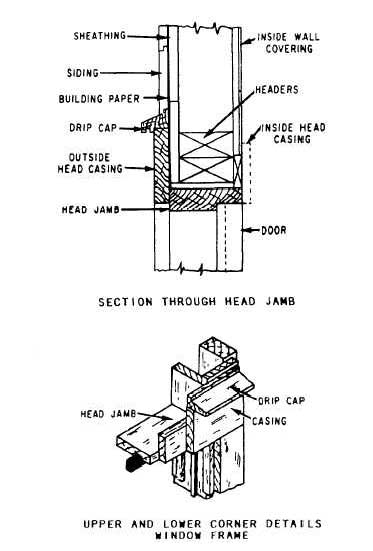lines) on the 12-inch-wide units indicate that the thickness of the wall beyond the pilaster is 8 inches. Note how the extra 4-inch thickness of the pilaster provides a center support for the girder, which, in turn, will support the floor joists.
Details are large-scale drawings that show the builders of a structure how its various parts are to be connected and placed. Although details do not use the cutting plane indication, they are closely related to sections. The construction of doors, windows, and eaves is customarily shown in detail drawings of buildings. Tyical door and window details are shown in figure 2-18. Detail drawings are used whenever the information provided in elevations, plans, and sections is not clear enough for the constructors on the job. These drawings are usually grouped so that references may be made easily from the general drawing.

Figure 2-18. - Door and window details.
SCHEDULES
LEARNING OBJECTIVE: Upon completing this section, you should be able to interpret building schedules.
A schedule is a group of general notes, usually grouped in a tabular form according to materials of construction. General notes refer to all notes on the drawing not accompanied by a leader and an arrowhead. Item schedules for doors, rooms, footings, and so on, are more detailed. Typical door and window finish schedule formats are presented in the next section.
DOOR SCHEDULE
Doors may be identified as to size, type, and style with code numbers placed next to each symbol in a plan view. This code number, or mark, is then entered on a line in a door schedule, and the principal characteristics of the door are entered in successive columns along the line. The "Amount Required" column allows a quantity check on doors of the same design as well as the total number of doors required. By using a number with a letter, you will find that the mark serves a double purpose: the number identifies the floor on which the door is located, and the letter identifies the door design. The "Remarks" column allows identification by type (panel or flush), style, and material. The schedule is a convenient way of presenting pertinent data without making the Builder refer to the specification. A typical door schedule is shown in table 2-1.
WINDOW SCHEDULE
A window schedule is similar to a door schedule in that it provides an organized presentation of the significant window characteristics. The mark used in the schedule is placed next to the window symbol that applies on the plan view of the elevation view (figure 2-13). A similar window schedule is shown in table 2-2.
FINISH SCHEDULE
A finish schedule specifies the interior finish material for each room and floor in the building. The finish schedule provides information for the walls, floors, ceilings, baseboards, doors, and window trim. An example of a finish schedule is shown in table 2-3.
Continue Reading